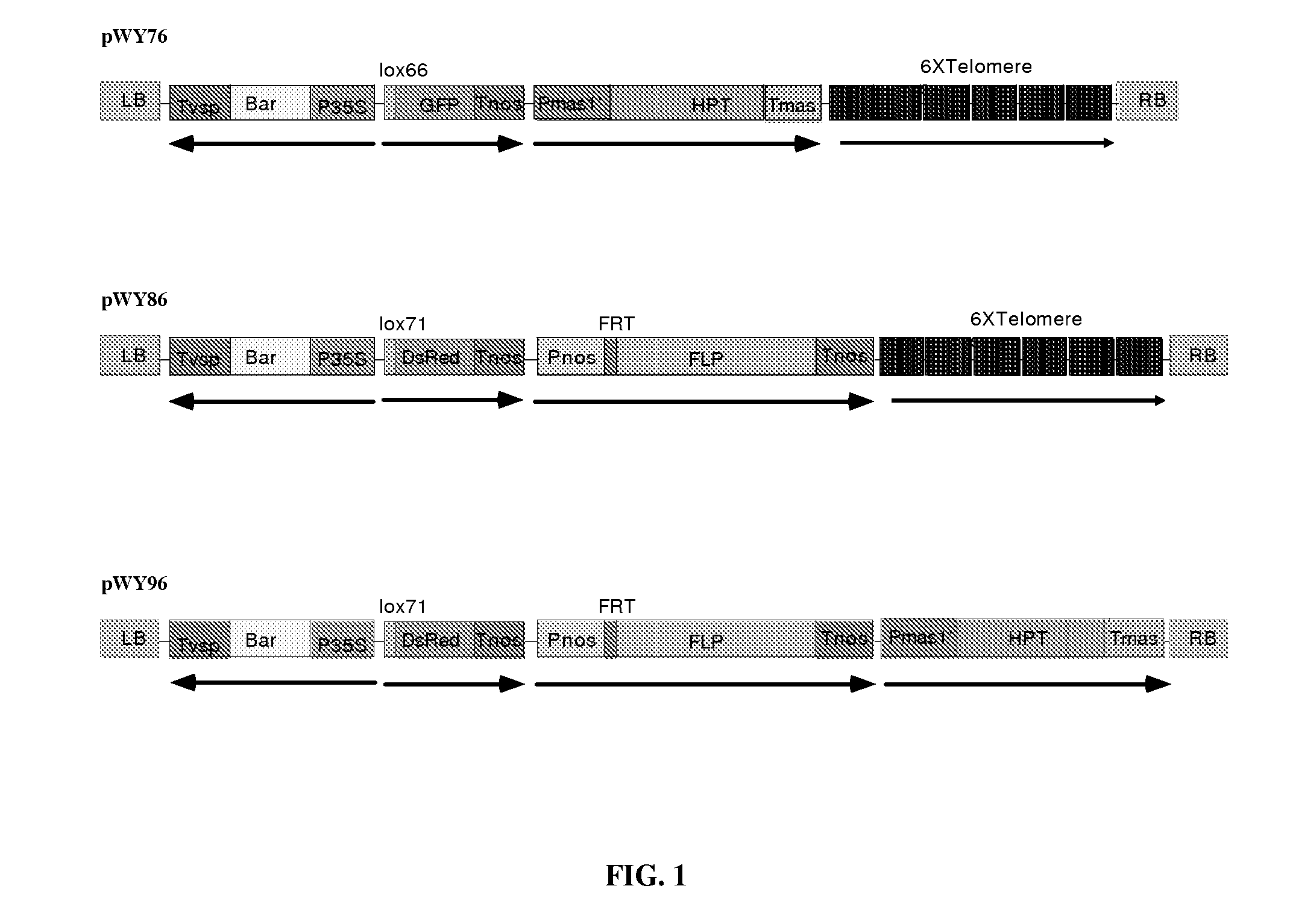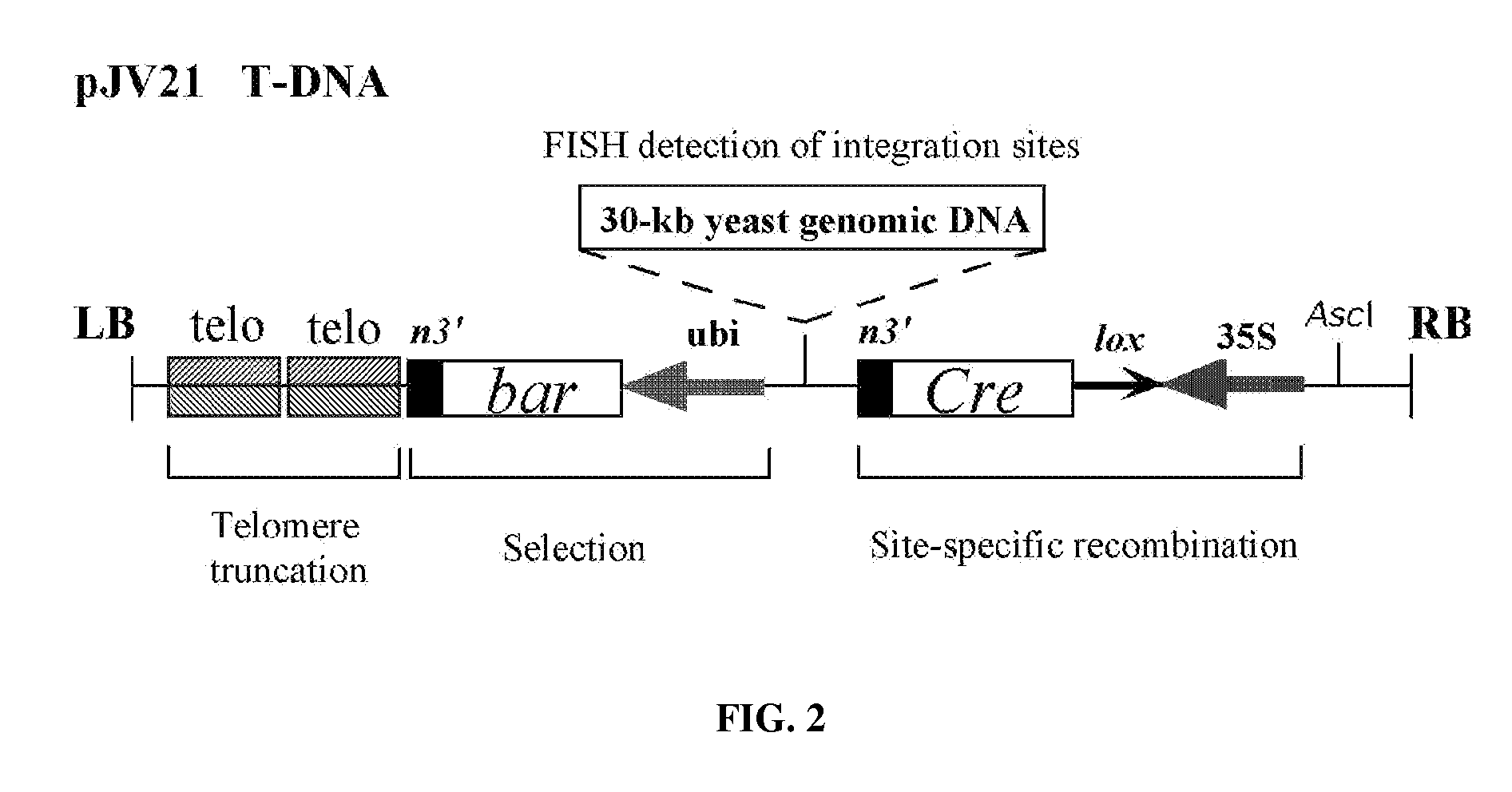Plant artificial chromosome platforms via telomere truncation
- Summary
- Abstract
- Description
- Claims
- Application Information
AI Technical Summary
Benefits of technology
Problems solved by technology
Method used
Image
Examples
example 1
General Telomere Truncation Methods
[0097] Telomere-mediated chromosomal truncation is accomplished by the introduction of six copies of telomere repeats into an endogenous plant chromosome via a transformation plasmid. In this particular case the telomere repeats were made from Arabidopsis telomeres previously cloned by Richards and Ausubel (1988). Maize HiII (Armstrong and Green, 1985) immature embryos were transformed following the protocols for Agrobacterium-mediated transformation with a standard binary vector (Frame et al., 2002). During the Agrobacterium-mediated transformation, the T-DNA is protected by Agrobacterium VirD2 and VirE proteins, and integrated into the plant genome by an illegitimate recombination mechanism. Small deletions may occur mostly in the left border region, and sometimes in the right border region. However, these deletions will not destroy the telomere sequence. The presence of the telomere repeats truncates the chromosome upon integration. The telomer...
example 2
Telomere Truncation in B-Chromosomes
[0103] To produce mini-B chromosomes by telomere-mediated chromosomal truncation, B chromosomes from Black Mexican Sweet (BMS) corn cells were introduced into a maize HiII parent A line and allowed to accumulate to multi-copies. The two telomere-associated chromosomal truncation constructs were mixed with a pACH25 construct (Christensen and Quail, 1996) for targeting HiII hybrid or HiII parent A immature embryos with multiple B chromosomes by biolistic transformation (Frame et al., 2000). The bar gene driven by a maize ubiquitin promoter in the pACH25 construct enables efficient selection of transgenic events on media supplemented with bialaphos. Telomere sequences on the constructs truncate B chromosomes as well as A chromosomes once integrated into the chromosomes, thus both minichromosomes from truncated B and A chromosomes can be produced. Root tip metaphase chromosomes obtained from regenerated herbicide resistant plants (T0) were screened b...
example 3
Expression of Cre Gene by Agrobacterium-Mediated Gene Transformation with a BIBAC Vector System
[0104] A BIBAC™ vector system was adopted for maize transformation with a large piece of genetic material including a herbicide resistance marker gene, a 30 kb yeast genomic DNA as a marker for fluorescence in situ hybridization (FISH), and a 35S-lox-Cre recombination cassette. Briefly, the BIBAC gene transformation plasmid pJV21 was constructed as follows. The pCH20 vector (Hamilton, 1997) was modified to deleted the BamHI to SwaI fragment. The BamHI site was reconstituted by adding a BamHI linker at the SwaI site followed with BamHI digestion and re-ligation. The resulting plasmid is named pJV06. A 3.4 kb HindIII / SalI fragment containing the 35S-loxP-Cre gene expression cassette from pED97 was cloned into the BamHI site by blunt end ligation to make pJV08. Next, a 400 bp telomere sequence and a ubi-bar gene expression cassette from pAHC25 (Christensen et al., 1992) were assembled in pBL...
PUM
| Property | Measurement | Unit |
|---|---|---|
| Fraction | aaaaa | aaaaa |
| Fraction | aaaaa | aaaaa |
| Digital information | aaaaa | aaaaa |
Abstract
Description
Claims
Application Information
 Login to View More
Login to View More - R&D
- Intellectual Property
- Life Sciences
- Materials
- Tech Scout
- Unparalleled Data Quality
- Higher Quality Content
- 60% Fewer Hallucinations
Browse by: Latest US Patents, China's latest patents, Technical Efficacy Thesaurus, Application Domain, Technology Topic, Popular Technical Reports.
© 2025 PatSnap. All rights reserved.Legal|Privacy policy|Modern Slavery Act Transparency Statement|Sitemap|About US| Contact US: help@patsnap.com



